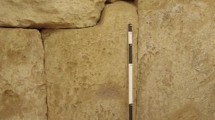Abstract
The prehistoric Bangudae Petroglyph in the Ulsan area represents an outstanding National Treasure of the Republic of Korea. Since the construction of the Sayeon dam, the petroglyph with about two hundred carvings is periodically submerged by the Sayeon reservoir. The danger of increasing damage has resulted in intensive efforts to protect this cultural heritage. Diagnosis and risk prognosis studies were carried out. Results of petrographical studies, monument mapping and in situ measurements are presented. Types, degree and zonation of damage are evaluated. The risk estimation derived from the studies confirms the necessity of preservation measures.


























Similar content being viewed by others
References
Fitzner B, Heinrichs K (2002) Damage diagnosis on stone monuments—weathering forms, damage categories and damage indices. In: Prikryl R, Viles H (eds) Understanding and managing stone decay. Proceedings of the international conference “Stone weathering and atmospheric pollution network” (SWAPNET 2001). Charles University, Prague, Karolinum Press, pp 11–56
Fitzner B, Heinrichs K, Kownatzki R (1995) Weathering forms—classification and mapping. Denkmalpflege und Naturwissenschaft, Natursteinkonservierung I. Ernst & Sohn, Berlin, pp 41–88
Fitzner B, Heinrichs K, La Bouchardiere D (2002) Damage index for stone monuments. In: Galan E, Zezza F (eds) Protection and conservation of the cultural heritage of the Mediterranean cities. Proceedings of the 5th international symposium on the conservation of monuments in the Mediterranean basin, Sevilla, Spain, 5–8 April 2000, Swets & Zeitlinger, Lisse / Netherlands, pp 315–326
Kim SJ (ed) (2002) Proceedings of the international symposium on the conservation of the Bangudae Petroglyph, Stone Conservation Science Laboratory, Ulsan City
Pettijohn FJ, Potter PE, Siever R (1987) Sand and sandstone, 2nd edn. Springer, Berlin Heidelberg New York
Acknowledgements
The authors would like to express their gratitude to the authorities of Ulsan Metropolitan City for the financial support of the studies on the Bangudae Petroglyph. The authors would like to thank Prof. Dr. Soo Jin Kim and his team from the Department of Geological Sciences, Seoul National University, for the cooperation, discussions and advice and for all logistical support of the works.
Author information
Authors and Affiliations
Corresponding author
Rights and permissions
About this article
Cite this article
Fitzner, B., Heinrichs, K. & La Bouchardiere, D. The Bangudae Petroglyph in Ulsan, Korea: studies on weathering damage and risk prognosis. Env Geol 46, 504–526 (2004). https://doi.org/10.1007/s00254-004-1052-x
Received:
Accepted:
Published:
Issue Date:
DOI: https://doi.org/10.1007/s00254-004-1052-x




